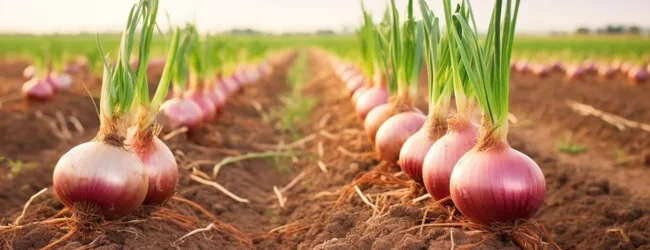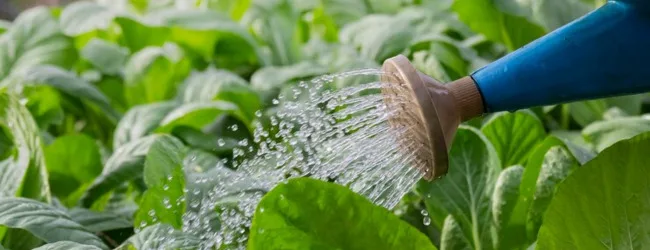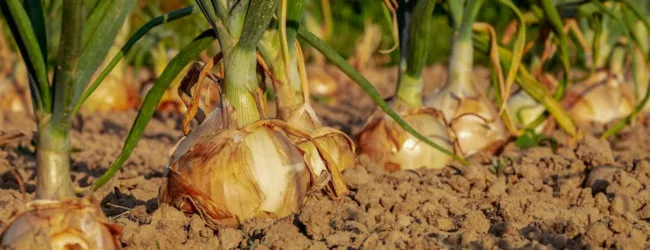Table of contents
Onion Farming in India holds significant importance for the country’s agriculture and economy. India is one of the largest onion producers globally, and this guide will walk you through every crucial aspect of successful onion farming in India, from initial setup to potential profits. Whether you are a seasoned farmer or a beginner looking to venture into agriculture, this comprehensive article will provide you with the knowledge and insights you need.
Why Onion Farming in India is a Promising Venture
- High Demand: Onions are a staple in Indian cuisine, ensuring consistent and high demand throughout the year.
- Government Support: The Indian government often introduces schemes and subsidies to support onion farmers, encouraging cultivation.
- Export Potential: Indian onions have a significant export market, providing opportunities for higher returns.
- Adaptability: Onions can be grown in various agro-climatic regions across India.
- Multiple Cropping Cycles: In some regions, farmers can harvest two to three onion crops in a year.
Step-by-Step Guide to Onion Farming in India

1. Choosing the Right Variety
- India boasts a diverse range of onion varieties, each suited to specific regions and seasons. Some popular varieties include:
- Red Onions: Agrifound Dark Red, Pusa Red, Nasik Red (widely cultivated in Maharashtra).
- White Onions: Agrifound White, Pusa White Round.
- Yellow Onions: Bhima Kiran.
- Key Consideration: Select varieties based on your local climate, soil type, market demand, and disease resistance. Choosing the right variety is crucial for maximising yield and quality.
2. Preparing the Land
- Soil Requirements: Onions thrive in well-drained, sandy loam to loamy soils rich in organic matter with a pH range of 6.0 to 7.5.
- Field Preparation:
- Plough the field thoroughly 2-3 times to achieve a fine tilth.
- Remove weeds and debris.
- Incorporate well-rotted farmyard manure (FYM) or compost (20-25 tonnes per hectare) during the final ploughing. Organic matter improves soil structure and water retention.
- Create raised beds or flatbeds depending on the irrigation method and soil type. Raised beds (15 cm high and 1-1.2 m wide) are generally preferred for better drainage.
3. Seed Sowing or Transplanting
- Nursery Raising (for transplanting):
- Sow seeds thinly on raised nursery beds (10-15 cm high, 1 m wide, and convenient length) prepared with FYM and sand.
- Cover the seeds with a thin layer of soil and irrigate gently.
- Seedlings are usually ready for transplanting in 4-6 weeks when they reach a height of 15-20 cm with 3-4 leaves.
- Direct Seed Sowing: This method is less common but can be practised in well-prepared fields. Use a seed drill to sow seeds at appropriate spacing.
- Spacing:
- For transplanted seedlings: Maintain a spacing of 15 cm between rows and 10 cm between plants within a row.
- For direct sowing: Adjust spacing based on the variety.
- Sowing Time: The ideal sowing time varies depending on the region and the targeted harvesting season (Kharif, Rabi, and summer crops). Consult your local agricultural extension office for specific recommendations.
💡 Pro Tip: If you want to start a farming business but have too many doubts, connect with a farming business expert from Boss Wallah for guidance – https://bw1.in/1116
4. Irrigation Management

- Onions require consistent moisture, especially during bulb development.
- Initial Stage: Irrigate immediately after sowing/transplanting and then every 3-4 days until the seedlings establish.
- Bulb Development Stage: Maintain adequate soil moisture. Irrigate at intervals of 7-10 days.
- Stop Irrigation: Stop irrigation about 15-20 days before harvesting to allow the bulbs to mature and develop a good skin.
- Efficient Methods: Consider using drip irrigation or sprinkler systems for efficient water use, especially in water-scarce regions. Drip irrigation can significantly reduce water consumption and improve yield.
5. Nutrient Management
- Onions are heavy feeders and require a balanced supply of nutrients.
- Basal Dose: Apply recommended doses of nitrogen (N), phosphorus (P), and potassium (K) fertilisers based on soil testing at the time of final land preparation. For example, a general recommendation might be 80:60:60 kg NPK per hectare.
- Top Dressing: Apply nitrogen in 2-3 splits during the vegetative growth stages.
- Micronutrients: In case of deficiencies, apply micronutrients like zinc, boron, and sulfur as per soil test recommendations.
- Biofertilizers: Incorporating biofertilizers like Azotobacter and PSB can enhance nutrient availability and reduce the reliance on chemical fertilisers.
6. Weed Control
- Weeds compete with onion plants for nutrients, water, and sunlight, significantly reducing yield.
- Manual Weeding: Regular hand weeding is effective, especially in the early stages.
- Mechanical Weeding: Inter-row cultivation can help control weeds.
- Herbicides: Selective herbicides can be used, but follow the manufacturer’s instructions carefully. Integrated weed management practices combining preventive, cultural, mechanical, and chemical methods are most effective.
7. Pest and Disease Management
- Onion crops are susceptible to various pests and diseases.
- Common Pests: Thrips, onion fly, cutworms.
- Common Diseases: Purple blotch, downy mildew, basal rot.
- Preventive Measures:
- Use disease-free seeds and seedlings.
- Practice crop rotation.
- Maintain proper field sanitation.
- Ensure good drainage.
- Control Measures:
- Use sticky traps to monitor and control flying insects.
- Apply recommended pesticides and fungicides at appropriate dosages when necessary.
- Consider biological control methods using beneficial insects or microorganisms. Early detection and timely intervention are crucial for effective pest and disease management.
8. Harvesting

- Onions are typically ready for harvest when the tops start yellowing and falling over (about 75% of the tops).
- Harvesting Time: This usually occurs 4-5 months after transplanting, depending on the variety and growing conditions.
- Method: Carefully pull out the bulbs along with the dried leaves. Avoid damaging the bulbs.
- Yield: The average yield of onions in India can range from 15-25 tonnes per hectare, but with good management practices, yields of 30-40 tonnes per hectare or even higher can be achieved.
9. Post-Harvest Handling and Storage
- Curing: After harvesting, leave the onion bulbs in the field under the sun for 2-3 days to dry and cure. This helps in removing excess moisture and prevents spoilage.
- Cleaning and Grading: Clean the bulbs to remove soil and damaged outer layers. Grade them based on size and quality.
- Storage: Onions can be stored for several months if proper conditions are maintained.
- Store them in well-ventilated, cool, and dry places.
- Traditional storage structures like khattis or improved ventilated structures are commonly used in India.
- Avoid storing damaged or diseased bulbs.
- Maintain a temperature of 0-4°C and 65-70% relative humidity for long-term storage (if using cold storage).
ALSO READ | Kiwi Farming in India: Technique, Investment, Profit Margin & More
Setup Cost and Profit in Onion Farming

Note: These are approximate figures and can vary significantly based on location, farm size, input costs, and market prices.
A. Setup Costs per Hectare (Indicative):
- Land Preparation (ploughing, levelling): ₹ 10,000 – ₹ 15,000
- Seeds/Seedlings: ₹ 5,000 – ₹ 10,000
- Fertilizers and Manure: ₹ 15,000 – ₹ 20,000
- Pesticides and Herbicides: ₹ 8,000 – ₹ 12,000
- Irrigation (including setup if new): ₹ 5,000 – ₹ 20,000 (depending on the method)
- Labour Costs (sowing, weeding, harvesting): ₹ 20,000 – ₹ 30,000
- Miscellaneous Costs (transportation, etc.): ₹ 5,000 – ₹ 8,000
- Total Estimated Setup Cost: ₹ 68,000 – ₹ 1,15,000 per hectare
B. Income and Profit per Hectare (Indicative):
- Average Yield: 20 tonnes per hectare (assuming average management)
- Average Market Price (fluctuates greatly): ₹ 10 – ₹ 20 per kg (this can vary significantly based on season and market demand). Let’s take an average of ₹ 15 per kg.
- Gross Income: 20,000 kg * ₹ 15/kg = ₹ 3,00,000
- Net Profit: ₹ 3,00,000 (Gross Income) – ₹ 68,000 – ₹ 1,15,000 (Total Setup Cost) = ₹ 1,85,000 – ₹ 2,32,000 per hectare
Real Business Example:
Mr. Ramesh, a farmer in Nashik, Maharashtra (a major onion-producing region), cultivates onions on his 2-hectare land. In the Rabi season (winter crop), he invested approximately ₹ 1,80,000 (₹ 90,000 per hectare) in land preparation, inputs, and labour. He harvested 45 tonnes of good-quality red onions (22.5 tonnes per hectare). He sold his produce at an average price of ₹ 18 per kg, earning a gross income of ₹ 8,10,000. His net profit for the season was ₹ 6,30,000 (₹ 3,15,000 per hectare). However, he acknowledges that prices can fluctuate significantly, impacting his profit margins in different seasons.
Key Point: Profitability in onion farming is highly dependent on market prices, which can be volatile. Farmers need to stay informed about market trends and explore options like direct marketing or value addition to enhance their returns.
ALSO READ | Terrace Farming in India: A Comprehensive and Elaborate Guide for 2025
Need Expert Guidance?
Starting a business can be challenging, but you don’t have to do it alone! At Boss Wallah, our 2,000+ business experts are ready to provide valuable insights and guidance. Whether you need help with marketing, finance, sourcing, or any other area of any business, our business experts are here to help you succeed- https://bw1.in/1116
Confused about Which Business to Start?
Want to start your own business but unsure which one to choose? Explore Boss Wallah, where you’ll find 500+ courses by successful business owners, featuring practical, step-by-step guides on starting and growing various businesses.
Find your perfect business idea today – https://bw1.in/1111
Conclusion
Onion farming in India presents a significant agricultural opportunity, driven by strong domestic demand and export potential. By following best practices in variety selection, land preparation, nutrient management, pest and disease control, and post-harvest handling, farmers can achieve good yields and profitability. While setup costs and market price fluctuations need careful consideration, the overall prospects for onion farming in India remain promising. Staying updated with the latest agricultural technologies, government schemes, and market information will further empower onion farmers to succeed.
Frequently Asked Questions (FAQs)
1. What is the best time to plant onions in India?
The best time varies regionally and depends on the targeted season (Kharif, Rabi, Summer). Generally, sowing for the Kharif crop starts in June-July, for the Rabi crop in October-November, and for the summer crop in January-February. Consult your local agricultural calendar for specific recommendations.
2. How much water do onions need?
Onions require consistent moisture, especially during bulb development. The frequency of irrigation depends on soil type, climate, and growth stage. Generally, irrigate every 3-4 days initially and then every 7-10 days during bulb development. Avoid overwatering, which can lead to diseases.
3. What are the major pests and diseases affecting onion crops in India?
Major pests include thrips, onion fly, and cutworms. Common diseases are purple blotch, downy mildew, and basal rot. Implementing integrated pest and disease management strategies is crucial for control.
4. What is the average yield of onion per hectare in India?
The average yield ranges from 15-25 tonnes per hectare under normal conditions. However, with improved farming practices and high-yielding varieties, yields of 30-40 tonnes per hectare or more can be achieved.
5. What are the important nutrients required for onion growth?
Onions require a balanced supply of nitrogen (for vegetative growth), phosphorus (for root and bulb development), and potassium (for overall plant health and bulb quality). Micronutrients like sulfur, zinc, and boron are also important. Soil testing helps determine the specific nutrient requirements.
6. How long does it take for an onion crop to mature?
The maturity period varies depending on the onion variety and growing conditions, typically ranging from 4 to 5 months after transplanting.
7. What are the different methods of onion storage in India?
Common storage methods include traditional open-air storage in well-ventilated areas or khattis, improved ventilated storage structures, and cold storage for long-term preservation. Proper curing and handling are essential for successful storage.
8. How can farmers increase their profit in onion farming?
Farmers can increase profits by:
- Adopting high-yielding varieties.
- Implementing efficient irrigation and nutrient management practices.
- Controlling pests and diseases effectively.
- Improving post-harvest handling and storage to reduce losses.
- Exploring direct marketing channels or value addition (e.g., onion paste, powder).
- Staying informed about market trends and selling at favourable prices.


